
The European green woodpecker is a large green woodpecker with a bright red crown and a black moustache. Males have a red centre to the moustache stripe which is absent in females. It is resident across much of Europe and the western Palearctic but in Spain and Portugal it is replaced by the similar Iberian green woodpecker.

Carpenter bees are species in the genus Xylocopa of the subfamily Xylocopinae. The genus includes some 500 bees in 31 subgenera. The common name "carpenter bee" derives from their nesting behavior; nearly all species burrow into hard plant material such as dead wood or bamboo. The main exceptions are species in the subgenus Proxylocopa, which dig nesting tunnels in suitable soil.

The New Zealand pea crab, is a species of small, parasitic crab that lives most commonly inside New Zealand green-lipped mussels. Adult females are about the size and shape of a pea, while adult males are smaller and flatter. Adult New Zealand pea crabs are completely reliant on their host mussel for shelter and food, which it steals from the mussel's gills. The New Zealand pea crab is found throughout New Zealand and can infect up to 70% of natural populations. These crabs are of concern to green-lipped mussel aquaculture because they reduce the size and growth of mussels, although infected mussels can be harvested and consumed.
Eduard Fuchs was a German Marxist scholar of culture and history, writer, art collector, and political activist.
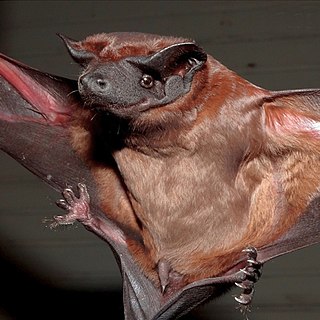
The cinnamon dog-faced bat, is a South American bat species of the family Molossidae. It is found in northern and central South America.
Ctenophryne aterrima is a species of frog in the family Microhylidae. It is found in northwestern Ecuador, the Andes of Colombia, and lowland and premontane zones of Panama and Costa Rica to about 1,600 m (5,200 ft) above sea level.

Stanwellia grisea, also known as the Melbourne trapdoor spider, is a species of mygalomorph spider in the Pycnothelidae family. It is endemic to Australia. It was described in 1901 by British arachnologist Henry Roughton Hogg.
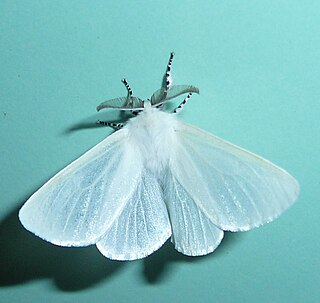
Leucoma salicis, the white satin moth or satin moth, is a moth of the family Erebidae. The species was first described by Carl Linnaeus in his 1758 10th edition of Systema Naturae. It is found in Europe including the British Isles but not the far north. In the east it is found across the Palearctic to Japan. Also in North America where it was introduced in the 1920s.

Colias aurorina, the Greek clouded butterfly or dawn clouded yellow, is a butterfly in the family Pieridae. It is found in Central Greece, the Near East and the Caucasus area. It is rare in former Yugoslavia.

Cuttlefish, or cuttles, are marine molluscs of the order Sepiida. They belong to the class Cephalopoda which also includes squid, octopuses, and nautiluses. Cuttlefish have a unique internal shell, the cuttlebone, which is used for control of buoyancy.
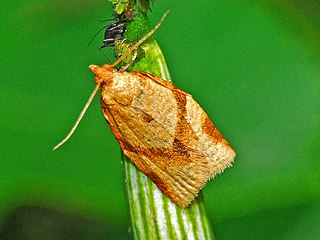
Clepsis consimilana, the privet tortrix, is a moth of the family Tortricidae.

Elophos vittaria is a moth of the family Geometridae first described by Carl Peter Thunberg in 1788. It is found in two separate areas in Europe. Subspecies mendicaria is found in the Alps and Mountains in central Europe, while subspecies vittaria is found from Fennoscandia, east through Russia and Asia to Japan.
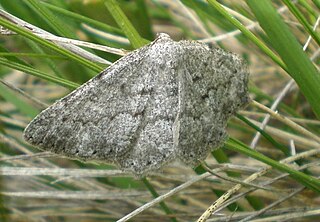
Elophos dognini is a moth of the family Geometridae. It is found in Spain, France, Andorra, Switzerland and Italy.
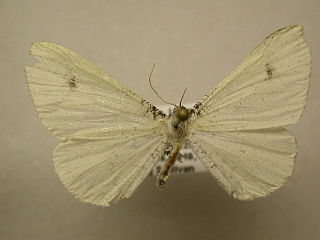
Macrosoma albida is moth-like butterfly described by William Schaus in 1901. It belongs to the family Hedylidae. Originally it belonged to the genus Hyphedyle.
Eoperipatus horsti is a species of velvet worm in the Peripatidae family. This species is brown with pale spots and a darker line running down the middle of its back. Females of this species have 24 or 25 pairs of legs; males have 23 or 24, usually 23. The males of this species can reach 40 mm in length, and the females can reach 46 mm in length, but the average specimen is 34 mm in length. The type locality is in West Malaysia.
Eoperipatus butleri is a Malaysian species of velvet worm in the Peripatidae family.

Langona manicata is a species of jumping spider in the genus Langona that lives in South Africa. The spider was first described by Eugène Simon in 1901. It is large, between 6 and 38 mm long, the female larger than the male. The female has a white-grey cephalothorax with a stripe down the middle while the male has a black cephalothorax. The female also has a stripe of its abdomen, which the male lacks. It is hard to differentiate from other Langona spiders, particularly Langona avara. The main distinguishing characteristic is the colour of the hairs on the single apophysis on the male pedipalp.

Charissa ambiguata is a species of moth that belongs to the genus Charissa.

The Patria 6×6 is a six-wheeled armoured personnel carrier produced by the Finnish defence industry company Patria.
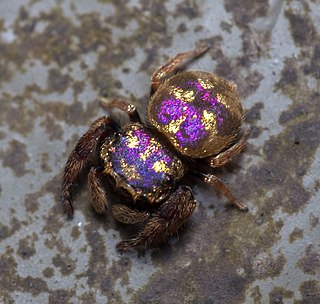
Irura bidenticulata, commonly known as the purple-gold jumping spider, is a species of salticid. As the name implies, while females tend to take on a more dull coloration, males are characterized by their striking, shiny magenta-gold patterned bodies. Discovered in 2011, the spider had initially been mistaken for a member of the Simaetha genus. Native to regions of Southeast Asia, it was first spotted in Hainan, China, having since also been located in the Saraburi province of Thailand, Cambodia, Hong Kong, and Assam.
















